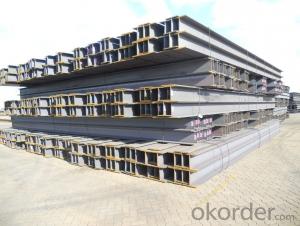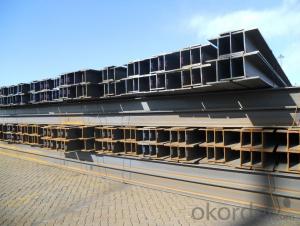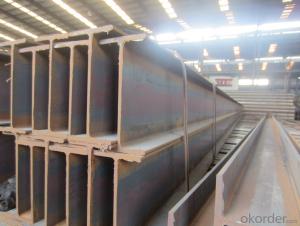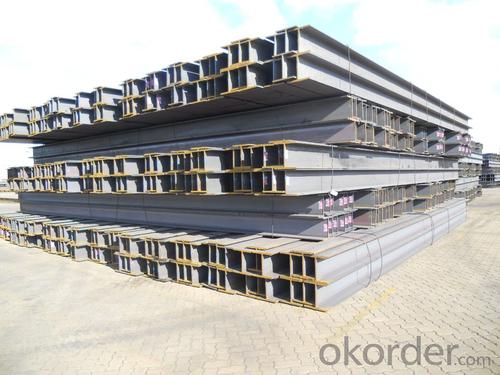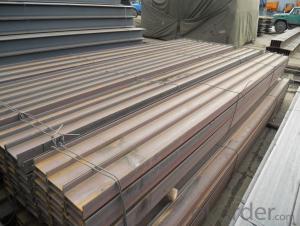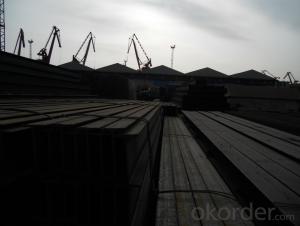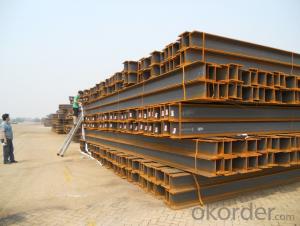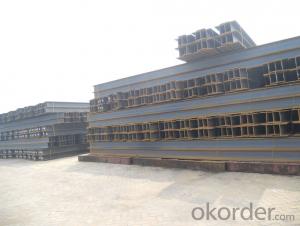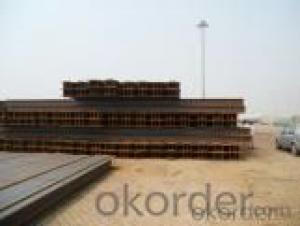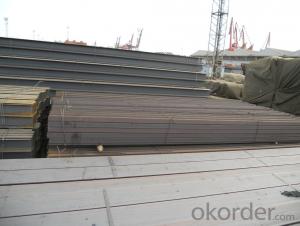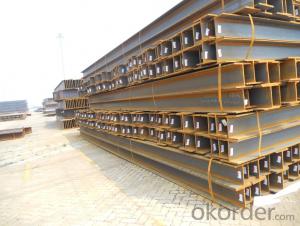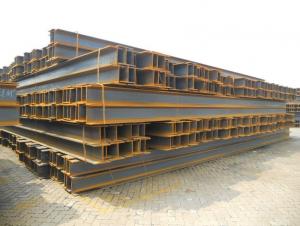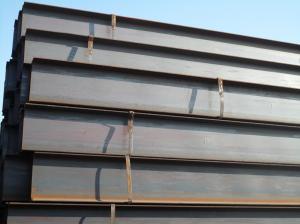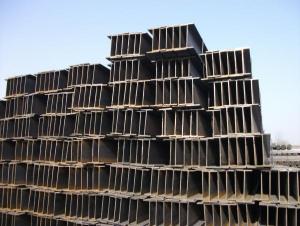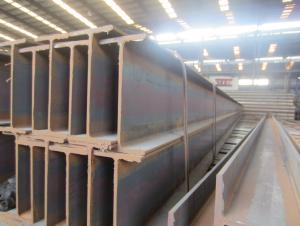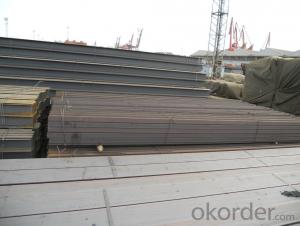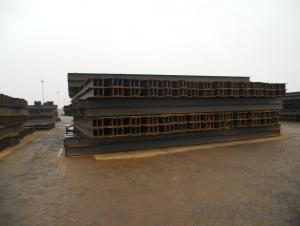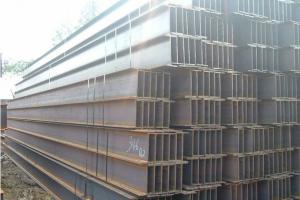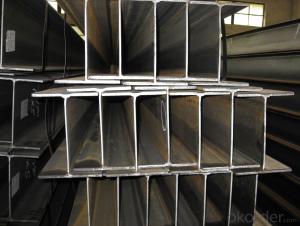JIS Standard Hot Rolled Steel H Beams for Construction
- Loading Port:
- Shanghai
- Payment Terms:
- TT or LC
- Min Order Qty:
- 25 m.t.
- Supply Capability:
- 200000 m.t./month
OKorder Service Pledge
OKorder Financial Service
You Might Also Like
Product Description:
OKorder is offering JIS Standard Hot Rolled Steel H Beams for Construction at great prices with worldwide shipping. Our supplier is a world-class manufacturer of steel, with our products utilized the world over. OKorder annually supplies products to African, South American and Asian markets. We provide quotations within 24 hours of receiving an inquiry and guarantee competitive prices.
Product Applications:
JIS Standard Hot Rolled Steel H Beams for Construction are ideal for structural applications and are widely used inindustrial plants, civil construction, municipal works, oil platforms, bridges, flatbed beams, electrified railway power stand, railway bridges and other light steel structure, super-light H-beam is ideal for containers, mobile homes , all kinds of garage, box-type trains, electrical bracket, various venues, small villa manufacturing etc.
Product Advantages:
OKorder's JIS Standard Hot Rolled Steel H Beams for Construction are durable, strong, and wide variety of sizes.
Main Product Features:
· Premium quality
· Prompt delivery & seaworthy packing (30 days after receiving deposit)
· Can be recycled and reused
· Mill test certification
· Professional Service
· Competitive pricing
Product Specifications:
JIS Standard Hot Rolled Steel H Beams for Construction
Grade: Q195 – 235
Certificates: ISO, SGS, BV, CIQ
Length: 12m, as per customer request
Packaging: Export packing, nude packing, bundled
| H BEAM | ||||||
| size | h (MM) | b (MM) | t1 (MM) | t2 (MM) | Mass: Kg/m | LENGTH |
| 100x100 | 100 | 100 | 6.0 | 8 | 16.9 | 12M |
| 125x125 | 125 | 125 | 6.5 | 9 | 23.6 | 12M |
| 150x75 | 150 | 75 | 5.0 | 7 | 14.0 | 12M |
| 148x100 | 148 | 100 | 6.0 | 9 | 20.7 | 12M |
| 150x150 | 150 | 150 | 7.0 | 10 | 31.1 | 12M |
| 175x90 | 175 | 90 | 5.0 | 8 | 18.0 | 12M |
| 175x175 | 175 | 175 | 5.0 | 11 | 40.4 | 12M |
| 198x99 | 198 | 99 | 4.5 | 7 | 17.8 | 12M |
| 200x100 | 200 | 100 | 5.5 | 8 | 20.9 | 12M |
| 194x150 | 194 | 150 | 6.0 | 9 | 29.9 | 12M |
| 200x200 | 200 | 200 | 8.0 | 12 | 49.9 | 12M |
| 200x204 | 200 | 204 | 12.0 | 12 | 56.2 | 12M |
| 248x124 | 248 | 124 | 5.0 | 8 | 25.1 | 12M |
| 250x125 | 250 | 125 | 6.0 | 9 | 29.0 | 12M |
| 244x175 | 244 | 175 | 7.0 | 11 | 43.6 | 12M |
| 250x250 | 250 | 250 | 9.0 | 14 | 71.8 | 12M |
| 250x255 | 250 | 255 | 14.0 | 14 | 81.6 | 12M |
| 298x149 | 298 | 149 | 5.5 | 8 | 32.0 | 12M |
| 300x150 | 300 | 150 | 6.5 | 9 | 36.7 | 12M |
FAQ:
Q1: Why buy Materials & Equipment from OKorder.com?
A1: All products offered byOKorder.com are carefully selected from China's most reliable manufacturing enterprises. Through its ISO certifications, OKorder.com adheres to the highest standards and a commitment to supply chain safety and customer satisfaction.
Q2: How many tons of steel products could be loaded in containers?
A2: Usually the steel products are delivered by bulk vessel because of the large quantity and the freight. However, there are no bulk vessel enter some seaports so that we have to deliver the cargo by containers. The 6m steel product can be loaded in 20FT container, but the quantity is changed according to the size, usually from 18tons to 25tons.
Q3: How soon can we receive the product after purchase?
A3: Within three days of placing an order, we will arrange production. The normal sizes with the normal grade can be produced within one month. The specific shipping date is dependent upon international and government factors, the delivery to international main port about 45-60days.
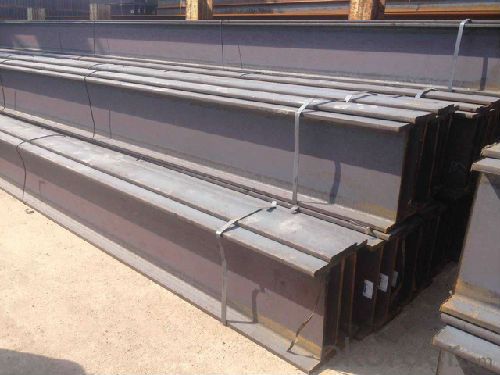
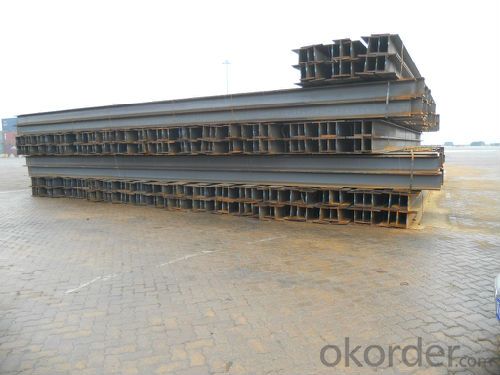
- Q: Can steel H-beams be used in the construction of theme resorts or hotels?
- Yes, steel H-beams can be used in the construction of theme resorts or hotels. Steel H-beams are commonly used in construction due to their strength, durability, and versatility. They provide excellent structural support and can withstand heavy loads, making them suitable for large-scale projects like theme resorts or hotels. The use of steel H-beams in construction offers several advantages. Firstly, they have a high load-bearing capacity, allowing for the construction of large and complex structures. This is particularly important in theme resorts or hotels, where there may be multiple levels or extensive open spaces that require strong structural support. Additionally, steel H-beams are known for their durability and resistance to environmental factors such as fire, earthquakes, and severe weather conditions. This ensures the safety and longevity of the theme resort or hotel, providing a secure and stable environment for guests. Furthermore, steel H-beams are versatile and can be easily customized to fit specific design requirements. They can be fabricated in various sizes and shapes, allowing architects and engineers to create unique and aesthetically pleasing structures that align with the theme or concept of the resort or hotel. Moreover, steel H-beams are cost-effective in the long run. While they may require a higher initial investment compared to other construction materials, their durability and low maintenance requirements make them a cost-efficient choice over the lifespan of the resort or hotel. In conclusion, steel H-beams are a suitable choice for the construction of theme resorts or hotels due to their strength, durability, versatility, and cost-effectiveness. They provide the structural support necessary for large-scale projects, ensuring the safety and longevity of the establishment.
- Q: Can steel H-beams be used in healthcare facilities and hospitals?
- Yes, steel H-beams can be used in healthcare facilities and hospitals. They are commonly used in the construction of these facilities due to their high strength, durability, and resistance to fire and corrosion. Steel H-beams provide structural support and stability, making them suitable for the demanding requirements of healthcare facilities and hospitals.
- Q: How should the steel H columns in the middle of the gable be placed?
- The wind column force calculation model, column base embedded in the top surface of the foundation, the upper pillar is flexible hinge, see is shown in the picture. Flexible hinge is a horizontal tie truss support, the node structure of the vertical horizontal is unconstrained, elastic constraint
- Q: What does H steel.R represent?
- It should mean the rounded radius of H steel.
- Q: Can steel H-beams be used in the construction of exhibition halls or convention centers?
- Yes, steel H-beams can be used in the construction of exhibition halls or convention centers. Steel H-beams are commonly used in commercial and industrial construction projects due to their strength, stability, and versatility. They provide structural support and can easily bear heavy loads, making them ideal for large-scale buildings like exhibition halls or convention centers where open space and long spans are required.
- Q: What are the different protective coatings available for steel H-beams?
- There are several different protective coatings available for steel H-beams that serve to enhance their durability and prevent corrosion. These coatings are specifically designed to withstand various environmental conditions and provide long-lasting protection. Some of the most commonly used protective coatings for steel H-beams include: 1. Galvanizing: This is one of the most widely used protective coatings for steel. Galvanizing involves applying a layer of zinc to the steel surface, creating a barrier that protects against rust and corrosion. It is highly effective in preventing damage caused by moisture, chemicals, and abrasion. 2. Epoxy Coatings: Epoxy coatings are often used to provide a high level of protection against chemicals, moisture, and UV rays. These coatings are resistant to abrasion and can be applied in various thicknesses, depending on the level of protection required. Epoxy coatings are commonly used in industries such as oil and gas, marine, and construction. 3. Powder Coating: Powder coating is a dry finishing process that involves applying a layer of powdered resin onto the steel surface. The coated steel is then heated, causing the powder to melt and form a protective layer. Powder coating provides excellent resistance against corrosion, chemicals, and UV rays. It also offers a wide range of color options, making it a popular choice for architectural applications. 4. Paint: Painting steel H-beams with a high-quality industrial paint is another common method of protection. The paint acts as a barrier against moisture, chemicals, and UV rays. It is important to use a paint specifically formulated for steel and to apply multiple coats to ensure adequate protection. 5. Metalizing: Metalizing involves applying a layer of molten metal, typically zinc or aluminum, onto the steel surface. This process provides excellent protection against corrosion and can be applied in various thicknesses depending on the level of protection required. Metalizing is commonly used in harsh environments such as marine and offshore applications. It is important to consider factors such as the intended use, environmental conditions, and budget when selecting a protective coating for steel H-beams. Consulting with a professional or coating specialist can help determine the most suitable coating for specific requirements, ensuring optimal protection and longevity for the steel H-beams.
- Q: How are steel H-beams connected or joined together in construction?
- Steel H-beams, also known as I-beams, find wide application in construction due to their strength and load-bearing capabilities. The connection or joining of these beams is accomplished using various techniques, depending on the specific construction project and its requirements. Welding stands as one of the most prevalent methods for joining steel H-beams. This technique involves heating the two beams at the connection point and subsequently fusing them together using a welding electrode. This results in a robust and enduring bond between the beams. Welding is extensively utilized in construction because it ensures a reliable and sturdy connection, thereby guaranteeing the structural integrity of the building. Bolting serves as another method employed to connect steel H-beams. It entails the use of bolts, nuts, and washers to secure the beams together at the connection point. Holes are drilled through the beams, and bolts are inserted and tightened using a wrench or spanner. Bolting is a popular choice as it allows for easy disassembly and reassembly, making it suitable for projects that may necessitate modifications or relocation in the future. In certain instances, steel H-beams can also be connected using rivets. Riveting involves the drilling of holes through both beams and subsequently inserting cylindrical metal pins known as rivets. These rivets are then hammered or compressed to securely fasten the beams together. Although riveting was extensively employed in the past, it has become less prevalent in modern construction due to the time-consuming nature of the process. Nevertheless, it can still be utilized in specific situations where the desire for aesthetically pleasing or historically significant riveted connections exists. Lastly, adhesive bonding can also be utilized to connect steel H-beams. This method entails the application of a strong adhesive or epoxy to the connection point, followed by the pressing of the beams together. Adhesive bonding offers the advantage of providing a clean and visually appealing connection without the need for visible welds or bolts. However, it is less commonly employed in construction due to the potential challenges involved in achieving a reliable and enduring bond. In conclusion, steel H-beams can be connected or joined together in construction through methods like welding, bolting, riveting, or adhesive bonding. The selection of the joining method depends on the specific project requirements, structural considerations, and aesthetic preferences.
- Q: What are the different bolt sizes used for steel H-beams?
- There are several different bolt sizes commonly used for steel H-beams, depending on the specific application and load requirements. The most commonly used bolt sizes for steel H-beams include M12, M16, M20, and M24. These bolt sizes are determined based on the strength and load capacity needed for the specific steel H-beam structure. Additionally, the length of the bolts may vary depending on the thickness and width of the H-beam. It is important to consult engineering specifications and calculations to determine the appropriate bolt sizes for a particular steel H-beam structure to ensure optimal strength and stability.
- Q: Can steel H-beams be used for sports arenas or stadiums?
- Yes, steel H-beams can be used for sports arenas or stadiums. They are commonly used in the construction of large-scale structures due to their high strength, durability, and load-bearing capacity. The H-beam's design allows for efficient structural support, making it suitable for withstanding the heavy loads and stresses experienced in sports arenas or stadiums.
- Q: What are the design considerations for steel H-beams in multi-story buildings?
- Design considerations for steel H-beams in multi-story buildings include the material's strength and durability, load-carrying capacity, stability and resistance to lateral forces, fireproofing measures, and the need for proper connections and anchoring to ensure structural integrity. Additionally, factors such as cost-effectiveness, ease of fabrication, and constructability should also be taken into account during the design process.
Send your message to us
JIS Standard Hot Rolled Steel H Beams for Construction
- Loading Port:
- Shanghai
- Payment Terms:
- TT or LC
- Min Order Qty:
- 25 m.t.
- Supply Capability:
- 200000 m.t./month
OKorder Service Pledge
OKorder Financial Service
Similar products
Hot products
Hot Searches
Related keywords
